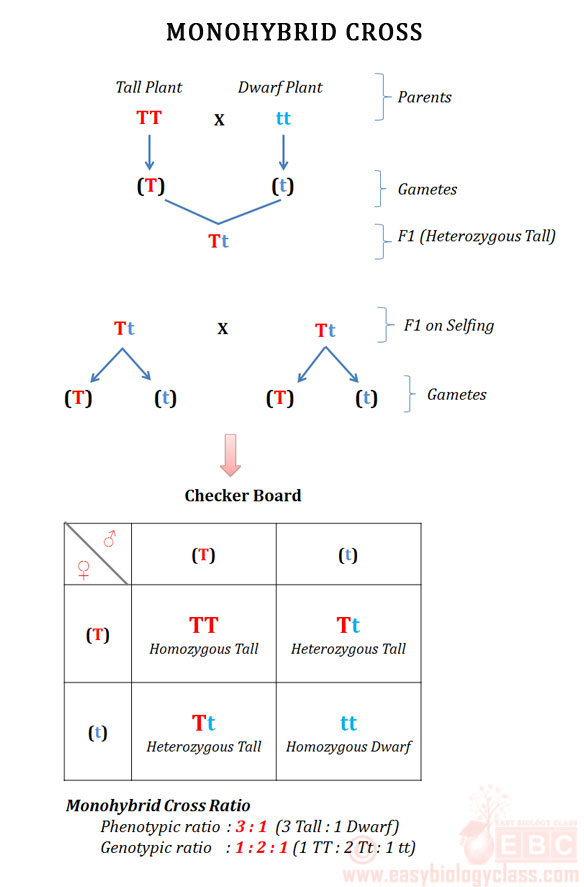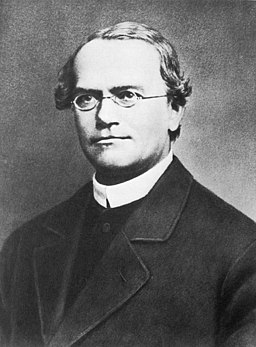Monohybrid Cross
Monohybrid cross is a type of hybridization experiment which involves the study of the inheritance of one pair of contrasting character. The alleles of contrasting characters selected in the monohybrid cross will show exact Dominance and Recessive relationships.
In Mendel’s classical experiment, he studied seven pairs of contrasting characters and carefully analyzed the segregation of these characters. Based on to the results from Mendel’s monohybrid cross two Mendelian laws were formulated. They were (1) Law of Dominance and (2) Law of Segregation or Law of Purity of Gametes. In this session, we will discuss Mendel’s original monohybrid cross and his conclusions regarding the results he obtained after the cross.
Mendel selected Pea plants for his hybridization experiments:
Pisum sativum or garden pea was the study material used by Gregor Johann Mendel (the Father of Modern Genetics) for his hybridization experiments. In one of his monohybrid cross, he selected plant height as the character. Plant height in Pisum sativum is controlled by a single gene with two contrasting alleles. The dominant allele of plant height is Tall and he represented it as ‘T’. The recessive allele for the plant height is Dwarf and he represented it as ‘t’. These two phenotypes were morphologically very distinct and can be differentiated very easily.
| You may also like NOTES in... | ||
|---|---|---|
| BOTANY | BIOCHEMISTRY | MOL. BIOLOGY |
| ZOOLOGY | MICROBIOLOGY | BIOSTATISTICS |
| ECOLOGY | IMMUNOLOGY | BIOTECHNOLOGY |
| GENETICS | EMBRYOLOGY | PHYSIOLOGY |
| EVOLUTION | BIOPHYSICS | BIOINFORMATICS |
Procedure of Monohybrid Cross
Ø Mendel selected two pea plants- one a true-breeding (homozygous) tall and the other a true-breeding dwarf.
Ø He generated these true-breeding parent plants by repeated selfing for several generations.
Ø In his experiment, Mendel crossed a homozygous Tall (TT) plant with a homozygous dwarf (tt) plant.
Ø The progenies of the first cross were called as the F1 generation (First filial generation).
Ø All the progenies of the F1 were tall (no dwarf individual).
Gregor Johann Mendel (Father of Genetics)
Ø Then he selfed the F1 plants to produce the next generation called F2.
Ø In the F2 generation, both tall and dwarf progenies were produced.
Ø Even though in the F2 generation, both tall and dwarf progenies were there, their number was NOT equal.
Ø Mendel observed that the progenies of F2 were in a ratio of 3 : 1 (3 tall : 1 dwarf).
Ø The F2 dwarf plant on selfing produced all dwarf progenies (F3 generation).
Ø The F2 tall plant on selfing, only 1/3 breed true (produce only tall plants).
Ø The 2/3 of the tall F2 on selfing produce tall and dwarf plants in 3 : 1 ratio (F3 generation).
Ø The details of the monohybrid cross are summarized in the following figure:

Ø Based on these observations, Mendel derived the following assumptions:
o The F2 generation actually consists of three types of plants. (Instead of the apparent two types). They were:
1. Tall homozygous (pure) : TT – 25%
2. Tall heterozygous (hybrid) : Tt – 50%
3. Dwarf homozygous (pure) : tt – 25%
Phenotypic ratio of monohybrid cross: 3 : 1 (3 tall : 1 dwarf)
Genotypic ratio of monohybrid cross: 1 : 2 : 1 (1 homozygous tall : 2 heterozygous tall : 1 homozygous dwarf)
Mendel’s explanations for his monohybrid cross:
Ø The Tall and Dwarf traits in plants are determined by a pair of contrasting factors (or determinants). These determinants or factors are now known as Genes.
Ø If a plant possesses the determinant for tallness (T) the plant will be tall in its phenotype.
Ø Similarly, if a plant possesses the determinant for dwarfness (t) the plant will be phenotypically dwarfed.
Ø The determinants for each character will occur in a pair and are received from their parents.
Ø If two alternatively expressing traits are brought tougher by sexual reproduction, only one will express in its heterozygous (Tt) condition.
Ø The one which expresses in its heterozygous condition is called Dominant trait (T).
Ø The other whose expression is suppressed or masked is called Recessive trait (t).
Ø In the case of plant height, from monohybrid cross, Mendel concluded that Tall is dominant and Dwarf is recessive.
Ø As we said earlier, the determinants will be in pairs in an individual.
Ø Even though they stay together (such as Tt) they never mix each other (or contaminate each other).
Ø When the individuals produce gamete the determinants will segregate and each enters to a different gamete.
Ø The factor ‘T’ (for tallness) and ‘t’ (for dwarfness) are thus two separate entities.
Ø Furthermore, in a gamete, there will be either ‘T’ or ‘t’ will be present.
Ø When the F1 hybrid (Tt) is selfed, the two entities separate or segregate out and unite independently produce tall and dwarf parts.
Mendel’s Laws of Inheritance
Ø Mendel postulated three laws based on his results from hybridization experiments in pea plants. They were:
(1). Law of Dominance
(2). Law of Segregation
(3). Law of Independent Assortment
Ø These laws were now known as Mendelian Laws of Inheritance.
Ø Among these three laws, the first two (Law of Dominance and Law of Segregation) were based on his results of monohybrid cross.
(1). Law of Dominance
This is the first law of Mendelian inheritance.
Definition: When two homozygous individuals with one or more sets of contrasting characters are crossed, the character that appears in the F1 is the DOMINANT character and those do not appear in the F1 is the RECESSIVE character.
Ø In Mendel’s monohybrid cross, tall (represented by ‘T’) is dominant and Dwarf (represented by ‘t’) is recessive characters.
Ø The law of dominance explains the reason for the nonappearance of recessive character in the F1 generation.
Ø In the F1, the genotype of the progeny will be ‘Tt’. Since ‘T’ is dominant over ‘t’, the recessive condition is suppressed and the dominant condition is expressed.
(2). Law of Segregation
Ø This is the second law of Mendelian inheritance.
Ø Law of segregation is also called as Law of Purity of Gametes.
Definition: When a pair of contrasting allele is brought together in a hybrid, the two members of the allelic pair remain together without any mixing and when gametes are formed from the hybrid, the two separate and segregate out from each other and moves to different gametes.
| You may also like... | ||
|---|---|---|
| NOTES | QUESTION BANK | COMPETITIVE EXAMS. |
| PPTs | UNIVERSITY EXAMS | DIFFERENCE BETWEEN.. |
| MCQs | PLUS ONE BIOLOGY | NEWS & JOBS |
| MOCK TESTS | PLUS TWO BIOLOGY | PRACTICAL |
Ø Pure tall plants (TT) will produce gametes only with ‘T’ allele.
Ø Similarly, pure dwarf plants (tt) will produce only gametes with ‘t’ allele.
Ø The hybrid tall (Tt) will produce two types of gametes, 50% will be with ‘T’ and the rest 50% will be with ‘t’ allele.
Ø The gametes are always pure for its tallness or dwarfness. This is called purity of gametes.
Key questions:
1. Mendel’s Monohybrid cross.
2. Explain the inheritance of plant height in Pea plants.
3. Define law of dominance.
4. Define law of segregation.
5. Why the law of segregation is known as law of purity of gametes.
6. Write an essay on Mendelian laws on inheritance with examples.



Thanks very much.